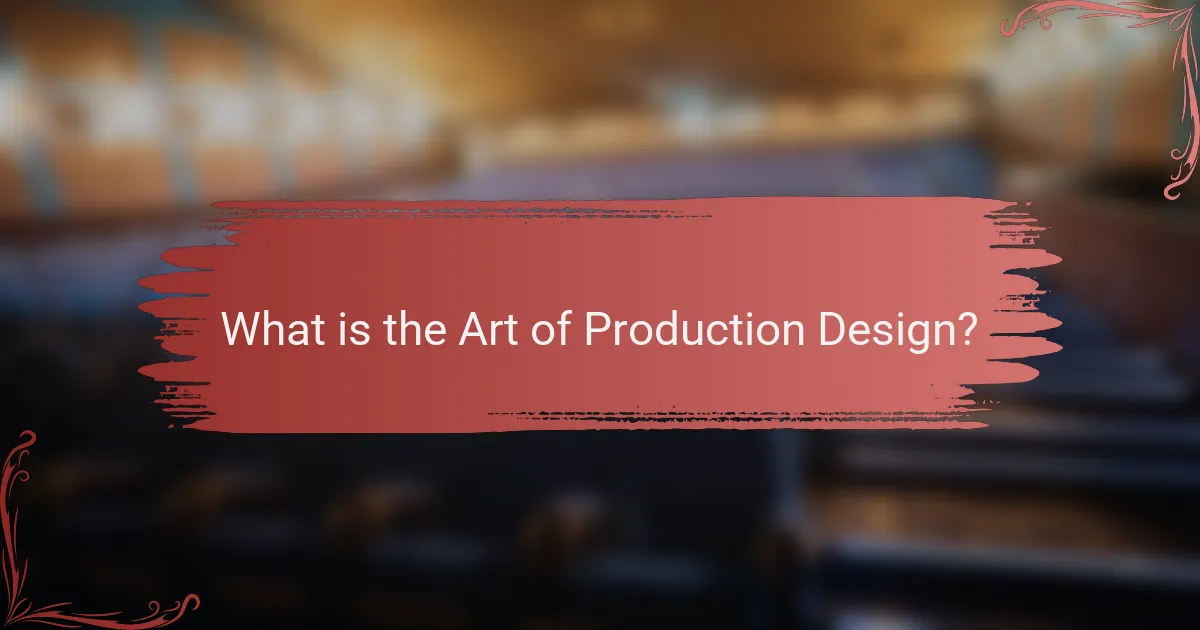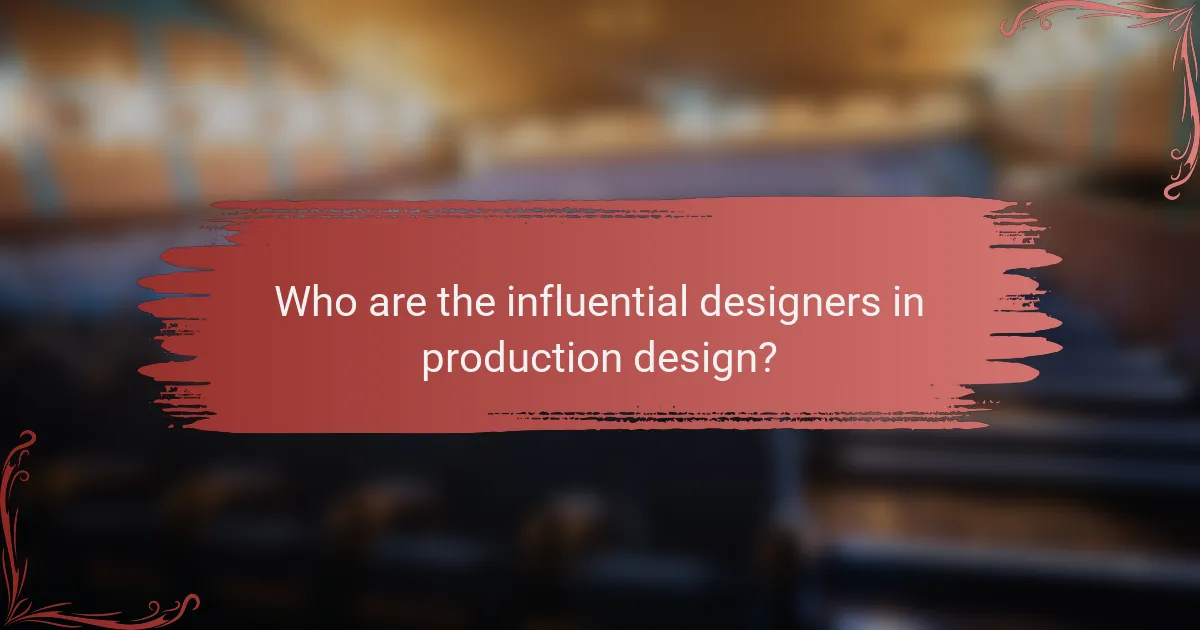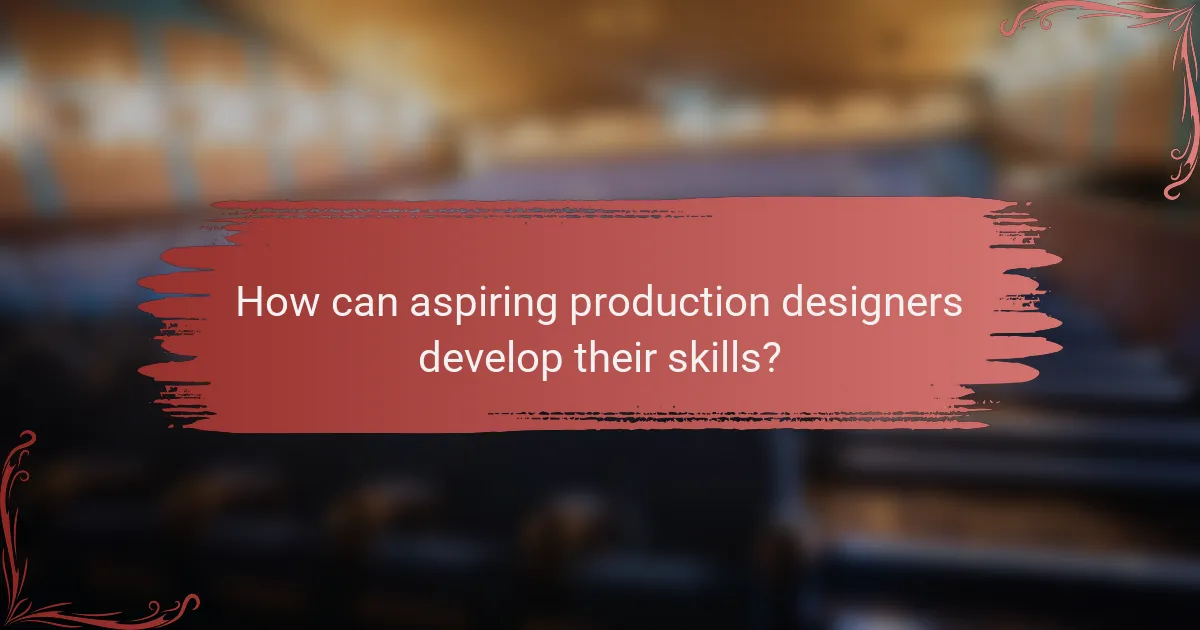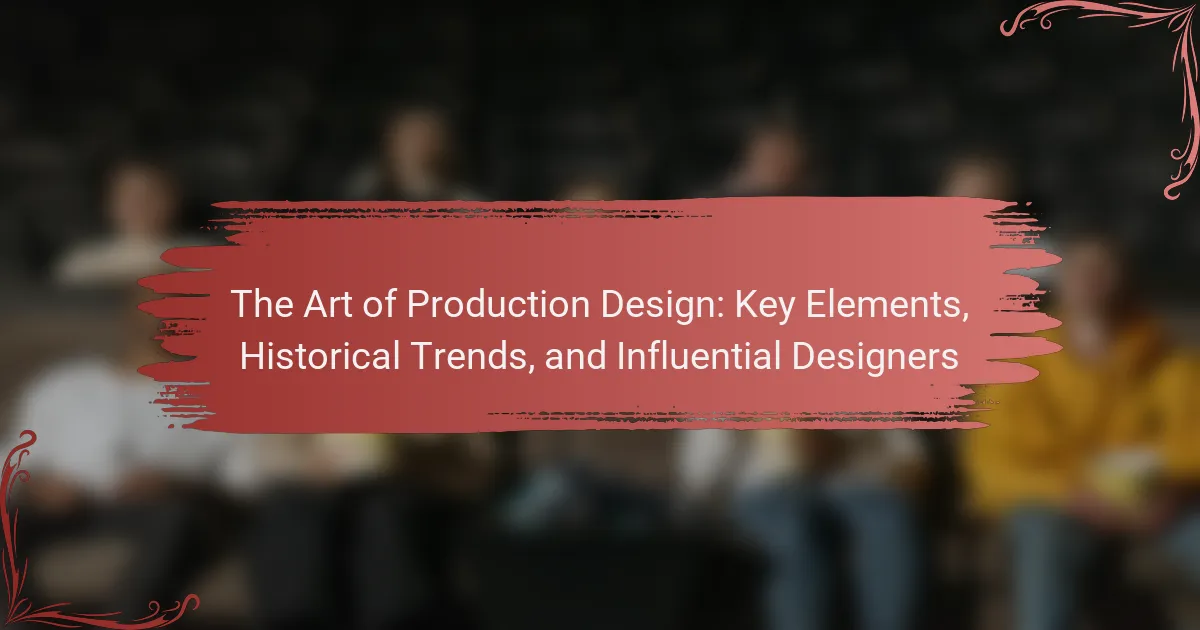Production design is the creative process of designing visual environments for film, television, and theater, focusing on aesthetic and functional aspects of a production’s setting. This discipline involves collaboration between production designers, directors, and cinematographers to establish the visual tone through elements such as color, texture, and space, enhancing storytelling. The article explores historical trends in production design, highlighting a shift from minimalism to elaborate sets, and discusses influential designers like Richard Sylbert, Ken Adam, and Dante Ferretti, who have significantly impacted the field. Additionally, it outlines pathways for aspiring production designers, emphasizing the importance of education, practical experience, and networking in developing their skills.

What is the Art of Production Design?
The Art of Production Design is the creative process of designing and creating visual environments for film, television, and theater. It encompasses the overall aesthetic and functional aspects of a production’s setting. Production designers collaborate with directors and cinematographers to establish the visual tone. They consider elements like color, texture, and space to enhance storytelling. This discipline has roots in theater and has evolved with technological advancements. Historical trends show a shift from minimalism to elaborate sets in various eras. Influential designers have shaped the field, bringing unique styles and innovations. Their work significantly impacts audience perception and immersion in the narrative.
How does production design influence visual storytelling?
Production design significantly influences visual storytelling by shaping the environment and aesthetics of a narrative. It establishes the mood, tone, and context of the story. For example, a dystopian setting can evoke feelings of despair and tension. Conversely, a vibrant and colorful design can create a sense of joy and optimism.
Production design also aids in character development. The surroundings can reflect a character’s personality or emotional state. A cluttered room may suggest chaos in a character’s life. In contrast, a minimalist space can denote clarity and focus.
Additionally, production design supports narrative continuity. Consistent design elements help maintain immersion for the audience. This coherence enhances the storytelling experience, making it more believable.
Historical examples illustrate this impact. In “Blade Runner,” the intricate design creates a hauntingly immersive world that complements the film’s themes. Similarly, “The Grand Budapest Hotel” uses a distinct visual style to enhance its whimsical narrative.
Overall, effective production design is essential for conveying the story’s essence and engaging the audience.
What are the key responsibilities of a production designer?
A production designer is responsible for the visual concept of a film, television show, or theater production. They create the overall look, including sets, locations, graphics, props, and costumes. This role involves collaborating with directors and producers to align the visual style with the narrative. Production designers also oversee the art department, managing budgets and timelines. They research and select materials that enhance the production’s aesthetic. Additionally, they must ensure that design elements are feasible within the production’s constraints. Their work significantly influences audience perception and immersion in the story.
How does production design integrate with other departments in film and theater?
Production design integrates with other departments in film and theater through collaboration and communication. It works closely with the director to establish the visual style of the production. The production designer coordinates with the art department to create sets, props, and costumes that align with the overall vision. Lighting and sound departments rely on production design to enhance the visual narrative. The integration ensures that every visual element supports the storytelling. For instance, the color palette chosen by production design can influence lighting choices. This collaboration is essential for maintaining continuity and coherence throughout the production. Effective integration leads to a unified artistic vision that enhances audience engagement.
What are the essential elements of production design?
The essential elements of production design include set design, props, color palette, and lighting. Set design creates the physical environment where the story unfolds. Props are objects used by actors to enhance storytelling. The color palette establishes the emotional tone of the production. Lighting influences the mood and visibility of scenes. These elements work together to create a cohesive visual narrative. Each element contributes to the overall aesthetic and storytelling of a production.
What role does color play in production design?
Color plays a crucial role in production design by influencing mood and perception. It helps to establish the visual identity of a project. Different colors evoke specific emotions and responses from the audience. For instance, warm colors like red and orange can create feelings of excitement or aggression. In contrast, cool colors such as blue and green often promote calmness and tranquility.
In addition, color schemes can enhance storytelling by reflecting character traits and themes. For example, a vibrant color palette may indicate a whimsical narrative, while a muted palette might suggest a more serious tone. Historical examples, such as the use of color in films like “The Wizard of Oz,” demonstrate the impact of color choices on viewer engagement.
Overall, color is an essential tool in production design that shapes the audience’s experience and understanding of the narrative.
How do set design and props contribute to the overall aesthetic?
Set design and props significantly enhance the overall aesthetic of a production. They create the visual framework that supports storytelling. Set design establishes the environment and mood, guiding audience perception. Props add layers of detail and authenticity to scenes. Together, they influence color schemes, textures, and spatial dynamics. Historical examples show that iconic films rely on meticulous set and prop choices. For instance, the elaborate sets in “The Great Gatsby” evoke the opulence of the Roaring Twenties. This synergy between set design and props shapes the viewer’s emotional experience and immersion in the narrative.
What historical trends have shaped production design?
Historical trends that have shaped production design include the evolution of technology, artistic movements, and cultural influences. The introduction of sound in films during the late 1920s necessitated new design techniques. The rise of modernism in the mid-20th century emphasized minimalism and functionality in design. The influence of postmodernism in the 1980s brought eclectic styles and historical references back into production design. Additionally, advancements in digital technology have transformed design processes since the 1990s. These trends reflect changing societal values and artistic expressions throughout history.
How did early cinema influence modern production design practices?
Early cinema significantly influenced modern production design practices through its innovative use of set design and visual storytelling. The introduction of elaborate sets in silent films established a standard for creating immersive environments. Filmmakers like D.W. Griffith utilized painted backdrops and intricate props to enhance narrative depth. This approach laid the groundwork for the importance of visual aesthetics in film. Modern production design continues to emphasize the integration of art and storytelling, echoing techniques from early cinema. The legacy of early filmmakers is evident in contemporary practices, where set design remains crucial for audience engagement and thematic expression.
What movements in art and architecture have impacted production design?
Several movements in art and architecture have significantly impacted production design. The Bauhaus movement emphasized functionality and simplicity, influencing modern production design aesthetics. Art Deco introduced luxurious materials and geometric forms, which can be seen in contemporary set designs. Surrealism inspired imaginative and dreamlike environments, affecting visual storytelling in production design. Minimalism focused on stripped-down aesthetics, promoting clarity and purpose in design choices. The Postmodern movement challenged traditional norms, allowing for eclectic and diverse design approaches. Each of these movements contributed unique philosophies and styles that shaped the evolution of production design across various media.

Who are the influential designers in production design?
Influential designers in production design include Richard Sylbert, Ken Adam, and Dante Ferretti. Richard Sylbert is known for his work on films like “Chinatown” and “The Graduate.” Ken Adam gained recognition for his iconic sets in the James Bond series, particularly “Dr. No.” Dante Ferretti is acclaimed for his collaborations with director Martin Scorsese, including “Hugo” and “Gangs of New York.” These designers have shaped the visual storytelling in cinema through their innovative and immersive set designs. Their contributions have set standards in the industry, earning multiple Academy Awards and nominations.
What contributions have notable production designers made to the industry?
Notable production designers have significantly shaped the film and television industry through their innovative visual storytelling. They create immersive environments that enhance narrative and emotional engagement. For example, production designer Rick Carter won an Academy Award for his work on “Avatar,” which showcased groundbreaking visual effects and world-building. His designs contributed to the film’s box office success, grossing over $2.8 billion worldwide. Another influential designer, Dante Ferretti, has received multiple Academy Awards for his intricate and historically accurate sets in films like “The Aviator.” His attention to detail elevates the authenticity of the cinematic experience. Additionally, production designers like Sarah Greenwood have transformed classic literature into visually stunning adaptations, as seen in “Pride & Prejudice.” Their contributions not only define the visual aesthetic of films but also influence trends in design and technology within the industry.
How did their unique styles redefine production design?
Their unique styles redefined production design by introducing innovative visual storytelling techniques. Designers like Ken Adam emphasized the use of large-scale sets to enhance narrative depth. His work on films like “Dr. Strangelove” showcased how elaborate environments could reflect themes. Similarly, production designer Dante Ferretti integrated rich textures and historical accuracy in films such as “The Aviator.” This approach added layers of authenticity and immersion. Designers also embraced technology, utilizing digital tools for more dynamic visuals. The shift towards collaborative processes with directors further transformed how design supports storytelling. Overall, these styles expanded the boundaries of creativity in production design.
What awards and recognitions have these designers received?
It is not possible to provide a specific answer regarding the awards and recognitions received by the designers mentioned, as the question lacks context about which designers are being referred to. Without identifying specific designers, I cannot accurately detail their awards or recognitions.
What are the common techniques used by successful production designers?
Successful production designers commonly use techniques such as conceptual sketching, mood boards, and 3D modeling. Conceptual sketching helps visualize ideas and communicate with the team. Mood boards provide a visual reference for color, texture, and style. 3D modeling allows for spatial planning and detailed design visualization. They also conduct thorough research on the project’s historical context and themes. Collaborating with directors and cinematographers ensures alignment with the overall vision. Effective use of materials and props enhances authenticity in design. These techniques contribute to creating immersive environments that support storytelling.
How do they approach research and concept development?
They approach research and concept development through thorough investigation and creative brainstorming. This process often begins with analyzing the script and understanding its themes. Designers gather visual references from various sources, including art, architecture, and historical contexts. They create mood boards to visualize the overall aesthetic. Collaboration with directors and cinematographers is essential for aligning concepts with the film’s vision. Iterative prototyping helps refine ideas based on feedback. Research may also involve location scouting to capture the essence of settings. This comprehensive approach ensures that the design is both innovative and contextually relevant.
What tools and technologies do they utilize in their work?
Production designers utilize various tools and technologies in their work. These include computer-aided design (CAD) software for creating detailed set plans. They often use 3D modeling software to visualize spaces and elements. Digital rendering tools help in presenting designs to directors and producers. Physical materials like foam core and wood are used for creating scale models. Additionally, they employ graphic design software for creating visuals and concept art. Virtual reality (VR) technology is increasingly used for immersive set design experiences. Collaboration tools facilitate communication with other departments. These tools enhance creativity and efficiency in the production design process.

How can aspiring production designers develop their skills?
Aspiring production designers can develop their skills through education and practical experience. They should pursue formal education in design, art, or theater. Many universities offer specialized programs in production design. Internships in film or theater productions provide hands-on experience. Networking with industry professionals can lead to mentorship opportunities. Attending workshops and seminars helps to learn new techniques. Studying existing works enhances understanding of design principles. Engaging in personal projects allows for creative experimentation. These methods collectively contribute to skill enhancement in production design.
What educational pathways are available for production design?
Educational pathways for production design include bachelor’s degrees, master’s degrees, and certificate programs. Many universities offer specialized programs in production design, film, or theater. These programs often cover essential skills such as set design, art direction, and visual storytelling. Internships and hands-on experience are also critical components of production design education. Networking opportunities are available through industry connections at educational institutions. Professional organizations may provide additional resources and training. Online courses can supplement traditional education, offering flexibility for students. Each pathway prepares students for various roles in the production design field.
What practical experiences are beneficial for a career in production design?
Internships in film or theater productions are beneficial for a career in production design. These experiences provide hands-on skills in set construction and design. Working alongside industry professionals offers insights into the production process. Volunteering for local theater groups enhances creativity and resourcefulness. Assisting on student films helps build a portfolio of work. Participating in workshops or classes focused on design techniques fosters technical knowledge. Networking with peers and mentors during these experiences can lead to job opportunities. Gaining experience with design software is increasingly important in the industry.
What tips can enhance a production designer’s portfolio?
To enhance a production designer’s portfolio, focus on showcasing diverse projects. Include a variety of styles and genres to demonstrate versatility. Highlight key projects that received recognition or awards. Use high-quality images to represent work effectively. Provide context for each project, detailing the design process and challenges faced. Incorporate sketches and concept art to illustrate the creative journey. Update the portfolio regularly with new work to reflect current skills. Seek feedback from industry professionals to improve presentation and content.
How can networking impact a production designer’s career opportunities?
Networking significantly enhances a production designer’s career opportunities. It allows for the establishment of valuable connections within the industry. These connections can lead to job referrals and collaborations on projects. Networking can provide access to industry events and workshops, facilitating skill development and exposure. According to a survey by the Production Designers Guild, 70% of jobs in the industry are filled through personal connections. Strong networking can also increase visibility among potential employers and clients. Ultimately, effective networking can open doors to higher-profile projects and long-term career growth.
What resources are available for ongoing learning in production design?
Online courses provide valuable resources for ongoing learning in production design. Platforms like Coursera and Udemy offer specialized courses. These courses cover various aspects of production design. Books on production design are also essential resources. Titles like “Production Design: Architects of the Screen” offer in-depth insights. Industry workshops and seminars provide hands-on experience. Networking with professionals can lead to mentorship opportunities. Online forums and communities foster discussion and knowledge sharing. These resources support continuous skill development in production design.
The Art of Production Design is the creative process of designing visual environments for film, television, and theater, focusing on aesthetic and functional aspects that enhance storytelling. This article covers key elements of production design, including set design, props, color palette, and lighting, while exploring historical trends and influential designers who have shaped the field. Additionally, it examines the integration of production design with other departments, the impact of color and set design on visual storytelling, and essential skills and educational pathways for aspiring production designers. Through this comprehensive overview, readers will gain insights into the critical role of production design in creating immersive narratives.
